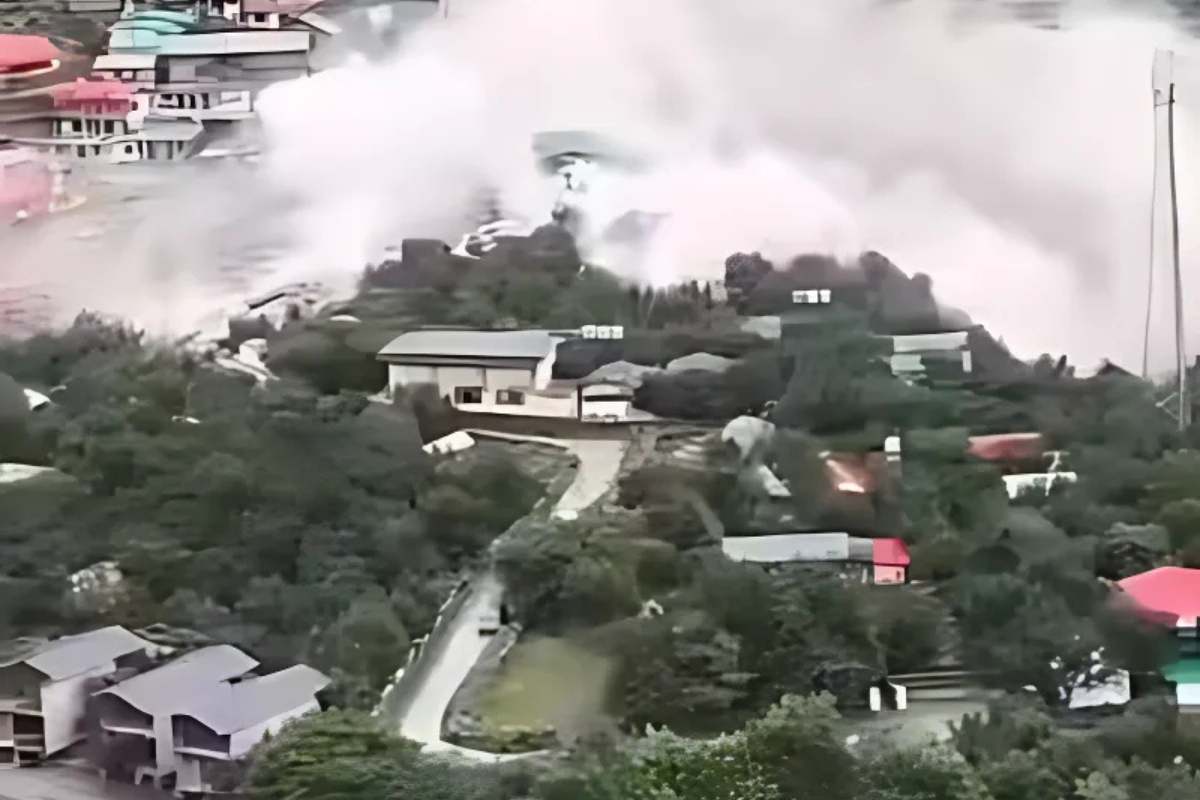Here’s what happened: no warning, no time to prepare. In the early hours of Tuesday morning, a devastating cloudburst ripped through Dharali, a picturesque high-altitude village in Uttarkashi district, Uttarakhand, India. One moment, calm. The next, utter chaos: Roaring walls of water charged through the village, sweeping away homes, hotels, roads, livelihoods, and possibly lives.
Officials and locals alike described scenes straight out of a nightmare. Entire houses gone in seconds. Hotels and homestays, popular with trekkers and pilgrims, simply vanished. Families fled for higher ground, clutching what little they could grab. As of now, several people are confirmed dead, dozens remain missing, and many more are feared to be trapped beneath mud and debris, the number shifting by the hour as search efforts continue.
What Exactly is a Cloudburst, And Why Here?
Let’s take a quick detour. A cloudburst is a sudden, intense rainfall that can dump over 100mm of rain in under an hour. Typically, the downpour is so heavy that it causes flash flooding almost instantly. And Uttarkashi, nestled in the Himalayas, plagued by unpredictable monsoon patterns, is a hotspot for such disasters. The mountains make things worse: rainwater races down slopes, gathering momentum, turning into violent torrents by the time it reaches valleys and villages like Dharali.
Funny thing is, this isn’t just a fluke or a once-in-a-lifetime event. History shows the region is no stranger to such calamities. Way back in 2013, Uttarakhand was battered by another round of flash floods, which killed thousands and caused billions in damage. Just another reminder of the unrelenting power of nature in these parts.
When the Waters Came: How the Flash Flood Unfolded
It starts, as always, with ominous clouds, and then, darkness. According to locals, the cloudburst occurred over the upper catchment area of the Kheer Ganga river, immediately above Dharali. It didn’t take long. Within minutes, a massive surge of water, mud, rocks, and debris thundered down upon the village.
Residents had little warning. Some were jolted awake by the crash of water against their homes. Others, catching sight of the flood from a distance, began shouting warnings. Videos shot by terrified villagers, quickly shared online, capture the brutal force of the deluge, rooftops and vehicles tossed around, panicked screams, and entire structures dissolving into the torrent.
As the clock ticked by, rivers burst their banks, streets vanished underwater, and bridges connecting Dharali to nearby localities collapsed. In places, what was once a bustling road now looked like a wide river choked with the remnants of somebody’s life.
Human Toll: What We Know So Far
How bad is it? The numbers, if I’m honest, are still coming in, rescue operations are ongoing, and the situation is, you know, fluid. As per initial reports:
- At least 4 people have been confirmed dead.
- Up to 50–60 villagers are missing, possibly trapped under the debris or swept away by the floodwaters.
- Roughly 10–12 residents feared buried, according to eyewitnesses at the scene.
- Around 20–25 hotels and homestays (yes, that many) reportedly destroyed, impacting both locals and stranded tourists.
- Several roads, power lines, and vital infrastructure were wiped out.
The terror on the ground? Palpable. Residents fled barefoot, clutching loved ones or nothing at all. “Sab khatam ho gaya (Everything is over),” one man can be heard saying in a video, surveying the wreckage as his house disappears beneath swirling, muddy water.
Rescue Operations: Racing Against Time
Within hours of the disaster, Uttarakhand’s chief minister, Pushkar Singh Dhami, announced the immediate deployment of emergency relief teams, including the National Disaster Response Force (NDRF), district police, and army units. Their mission, search for survivors, provide medical aid, and restore communication links severed by the flood.
But here’s the kicker: the region’s remote, mountainous location is making things tough. Telephone networks are patchy. Many roads have been swallowed by landslides or washed away altogether, making access to certain pockets almost impossible. Emergency crews are relying on whatever detours, footpaths, or airlifts they can muster.
Local officials, including the district magistrate Prant Ary, confirmed they’ve dispatched teams “to the site as fast as possible, but the terrain and ongoing weather challenges are slowing progress.”
Here’s an eye-opener: In some cases, villagers themselves have become first responders, digging through debris with their bare hands, searching for signs of life, all while keeping an anxious eye on the still-threatening sky.
Why Dharali? A Closer Look at the Village
Funny thing, until this moment, Dharali was better known as a tranquil Himalayan getaway, not a disaster zone.
- Located roughly 19km from Harsil, Dharali sits on the banks of the Bhagirathi river, a major tributary of the Ganges.
- It’s a magnet for tourists, trekkers, and pilgrims on their way to Gangotri, one of Hinduism’s holiest sites.
- The area is dotted with hotels, guesthouses, and shops catering to thousands of seasonal visitors every year.
But, here’s the stark reality, its location also makes it uniquely vulnerable. Sandwiched between steep slopes and riverbanks, Dharali is exposed to both landslides and rapid water surges, especially during the monsoon. When the heavens open up, there’s nowhere for water to go but down, fast.
And when infrastructure isn’t built to withstand disasters of this scale, villages like Dharali are, frankly, sitting ducks.
Eyewitness Stories: Ordinary Villagers, Extraordinary Resilience
Quotes from the ground tell the tale better than numbers alone:
“We heard a loud roar and then, suddenly, water rushed in from all sides. My house just disappeared. I tried to help my neighbors, but there was so little time,” said Rajesh Panwar, a villager who narrowly escaped by climbing to higher ground.
Other survivors describe how they saw family members swept away. Shopkeepers watched, helpless, as years of hard work were reduced to rubble within minutes. Some spent the night shivering under open sky, too afraid to return, even as incessant rainfall continued in the area.
The Aftermath: What Happens Now?
Truth is, the next phase, recovery, is a long, grueling process.
- Immediate Priorities: Search and rescue. Account for everyone missing. Provide emergency shelter, food, water, and medical care to survivors.
- Restoration of Communication: Engineers are racing to repair downed lines. In this part of the Himalayas, a working mobile phone can mean the difference between life and death.
- Assessment of Damage: Local authorities expect the final toll of homes, businesses, and lives lost to rise as debris is cleared and communications improve.
- Long-Term Aid: The Uttarakhand government, along with NGOs, has announced emergency relief funds and temporary accommodation for the displaced. But with monsoon season far from over, everyone’s bracing for more rain and potential landslides in the coming weeks.
A Pattern of Vulnerability: Why Uttarakhand Keeps Suffering
Uttarakhand isn’t new to disaster. The Himalayan state’s unique geography, high peaks, deep river valleys, and shifting monsoon patterns make it especially prone to:
- Cloudbursts and flash floods (like this week’s tragedy)
- Landslides, which often follow heavy downpours
- Glacial lake outburst floods (GLOFs), due to rapidly melting glaciers upstream
Climate change, many scientists warn, is making extreme weather events more frequent and more intense. Rising temperatures, erratic rainfall, and retreating glaciers set the stage for disasters like those in Dharali.
On top of nature’s fury, unplanned development and rapid infrastructure expansion have worsened the risks. Roads are often cut into unstable hillsides. Concrete construction encroaches upon floodplains. Proper land-use planning? Often, sadly, overlooked until tragedy strikes.
The Broader Picture: Echoes Across India
Believe it or not, Uttarakhand’s plight is echoed across India’s Himalayan belt. Himachal Pradesh, Assam, and Sikkim each face deadly floods and erosion, year after year.
Rescue teams become experts at clearing landslides and reuniting families. Villagers become resilient, if weary, survivors of a seemingly endless cycle, repair, rebuild, relive.
And every time the monsoon clouds gather, memories of past disasters return. For many, it’s not a question of if, but when the next one will hit.
Viral Videos: Social Media as Lifeline, and Lifeline for Reality
In 2025, most of the world didn’t learn about Dharali’s disaster from government press releases. It was those firsthand smartphone videos, floodwaters sweeping away homes, villagers screaming, heartbreak laid bare in real time, that went viral within hours. People thousands of miles away could almost feel, viscerally, the panic of a village swallowed by water.
These videos aren’t just a lifeline for awareness. They also sometimes drive more rapid mobilization of relief resources, and push authorities to act with urgency when the whole world is watching.
Lessons Learned: The Unanswered Questions
Here’s the toughest question: Can villages like Dharali ever really be safe? There is no easy answer. Meanwhile, local and national authorities are facing mounting pressure to overhaul disaster preparedness for India’s vulnerable hill regions. This means:
- Early-warning systems for rainfall and floods
- Stricter guidelines for riverside and hillside construction
- Improved evacuation and community preparedness drills
- Long-term climate adaptation plans
Yet, for now, survival is the only immediate priority. The residents of Dharali and the wider Uttarkashi district will have to rebuild, once more, from the ground up.
Final Word: In Dharali, Grief and Hope Intertwined
Somewhere up in the mountains, as rescue workers pick through debris and villagers wait for news of missing loved ones, there’s an overwhelming sense of loss. Yet, against all odds, there is also resilience. Families sheltering together, strangers sharing food, volunteers scrambling to dig out survivors.
This story, like so many others from Uttarakhand, is a stubborn reminder of just how unforgiving nature can be. Yet, it’s also proof that even when everything is swept away, hope, if I’m honest, somehow floats.
Key Facts at a Glance
- Disaster: Cloudburst-triggered flash flood
- Date: Early morning, August 5, 2025
- Location: Dharali village, Uttarkashi district, Uttarakhand, India
- Impact: 4 fatalities confirmed so far, 50–60 missing, several homes, roads, hotels swept away, major infrastructure damaged
- Response: Ongoing rescue and relief operations, led by government and local volunteers
- Long-term Risks: Repeated exposure to extreme weather and flooding in the Himalayan region
Stay tuned for ongoing updates as the full extent of the tragedy unfolds, and as Uttarakhand strives to recover, once again, from the devastating force of sudden flash floods.






















